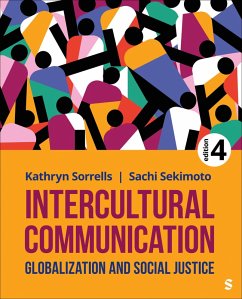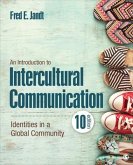- Broschiertes Buch
- Merkliste
- Auf die Merkliste
- Bewerten Bewerten
- Teilen
- Produkt teilen
- Produkterinnerung
- Produkterinnerung
Intercultural Communication: Globalization and Social Justice, Fourth Edition, introduces students to the study of communication among cultures within the broader context of globalization. Through a social justice approach, this text equips students with the skills and knowledge to create a more equitable world through communication.
Andere Kunden interessierten sich auch für
![An Introduction to Intercultural Communication An Introduction to Intercultural Communication]() Fred E JandtAn Introduction to Intercultural Communication141,99 €
Fred E JandtAn Introduction to Intercultural Communication141,99 €![Globalizing Intercultural Communication Globalizing Intercultural Communication]() Globalizing Intercultural Communication151,99 €
Globalizing Intercultural Communication151,99 €![An Introduction to Intercultural Communication An Introduction to Intercultural Communication]() Fred E JandtAn Introduction to Intercultural Communication141,99 €
Fred E JandtAn Introduction to Intercultural Communication141,99 €![Intercultural Communication Intercultural Communication]() Larry SamovarIntercultural Communication188,99 €
Larry SamovarIntercultural Communication188,99 €![The Communication Age The Communication Age]() Autumn EdwardsThe Communication Age150,99 €
Autumn EdwardsThe Communication Age150,99 €![Interpersonal Communication Interpersonal Communication]() Richard WestInterpersonal Communication191,99 €
Richard WestInterpersonal Communication191,99 €![Communication in Action Communication in Action]() Jonathan Michael BowmanCommunication in Action126,99 €
Jonathan Michael BowmanCommunication in Action126,99 €-
-
-
Intercultural Communication: Globalization and Social Justice, Fourth Edition, introduces students to the study of communication among cultures within the broader context of globalization. Through a social justice approach, this text equips students with the skills and knowledge to create a more equitable world through communication.
Produktdetails
- Produktdetails
- Verlag: Sage Publications Inc Ebooks
- 4 Revised edition
- Seitenzahl: 416
- Erscheinungstermin: 14. November 2025
- Englisch
- Abmessung: 231mm x 187mm
- ISBN-13: 9781071917954
- ISBN-10: 1071917951
- Artikelnr.: 73778540
- Herstellerkennzeichnung
- Libri GmbH
- Europaallee 1
- 36244 Bad Hersfeld
- gpsr@libri.de
- Verlag: Sage Publications Inc Ebooks
- 4 Revised edition
- Seitenzahl: 416
- Erscheinungstermin: 14. November 2025
- Englisch
- Abmessung: 231mm x 187mm
- ISBN-13: 9781071917954
- ISBN-10: 1071917951
- Artikelnr.: 73778540
- Herstellerkennzeichnung
- Libri GmbH
- Europaallee 1
- 36244 Bad Hersfeld
- gpsr@libri.de
Kathryn Sorrells is Professor of Communication Studies at California State University, Northridge (CSUN), and is currently serving as Department Chair. She teaches undergraduate and graduate courses in intercultural communication, critical pedagogy, performance, cultural studies, and feminist theory. She combines critical/cultural studies and postcolonial perspectives to explore issues of culture, race, gender, class, and sexuality. Kathryn grew up in Georgia; has lived in different regions of the United States; has studied and worked in Brazil, Japan, Turkey and China; and has traveled extensively in Asia, Europe, and parts of Latin America. The critical, social justice approach she uses to study and practice intercultural communication is informed by her experiences growing up in the South during the tumultuous and transformative civil rights movement and her subsequent participation in the antiwar; women's; lesbian, gay, bisexual, and transgender (LGBT); and labor and immigrant rights movements. Kathryn has published a variety of articles related to intercultural communication, globalization, and social justice and is co-editor along with Sachi Sekimoto of Globalizing Intercultural Communication: A Reader (Sage, 2015). She has been instrumental in organizing a campus-wide initiative on Civil Discourse and Social Change at CSUN aimed at developing students' capacities for civic engagement and social justice. Kathryn is a recipient of numerous national, state, and local community service awards for founding and directing Communicating Common Ground, an innovative service learning project that provided students opportunities to develop creative alternatives to intercultural conflict. Additionally, Kathryn has experience as a consultant and trainer for nonprofit, profit and educational organizations in the areas of intercultural communication and multicultural learning.
Preface
Acknowledgments
About the Author
Chapter 1: Opening the Conversation: Studying Intercultural Communication
Intercultural Communication in Global Contexts
Definitions of Culture
Situating Yourself as Intercultural Communicator
Intercultural Praxis in the Context of Globalization
Summary
Key Terms
Discussion Questions and Activities
Chapter 2: Understanding the Context of Globalization
Influences of Globalization on Intercultural Communication
The Role of History in Intercultural Communication
Intercultural Dimensions of Economic Globalization
Intercultural Dimensions of Political Globalization
Intercultural Dimensions of Cultural Globalization
Summary
Key Terms
Discussion Questions and Activities
Chapter 3: Globalizing Body Politics: Embodied Verbal and Nonverbal
Communication
Body Politics and Intercultural Communication
Constructing Social Worlds Through Communication
The Social Construction of Race: From Colonization to Globalization
Resignifying Race in The Context of Globalization
Becoming Anti-Racist
Summary
Key Terms
Discussion Questions and Activities
Chapter 4: (Dis)Placing Culture and Cultural Space: Locations of Nonverbal
and Verbal Communication
Placing Culture and Cultural Space
Displacing Culture and Cultural Space
Case Study: Hip Hop Culture
Cultural Space, Power, and Communication
Summary
Key Terms
Discussion Questions and Activities
Chapter 5: Privileging Relationships: Intercultural Communication in
Interpersonal Contexts
Intercultural Relationships: Historical and Contemporary Contexts
Topography of Intercultural Relationships
Intercultural Relationships in the Workplace
Intercultural Friendships
Intercultural Romantic Relationships
Cyberspace, AI, and Intercultural Relationships
Summary
Key Terms
Discussion Questions and Activities
Chapter 6: Crossing Borders: Migration and Intercultural Adaptation
The World on the Move
Types of Migrants
Historical Overview of World Migration
Migration Trends in the Context of Globalization
Theories of Migration and Intercultural Adaptation
Case Study 1: Villachuato, Mexico, to Marshalltown, Iowa: Transnational
Connections
Case Study 2: Mumbai, India, to New York City, USA: International Student
Adaptation and the Challenges of Immigration
Case Study 3: Destination Portugal: Different Stories for Workers and the
Retirees
Summary
Key Terms
Discussion Questions and Activities
Chapter7: Jamming Media and Popular Culture: Analyzing Messages About
Diverse Cultures
Popular Culture and Intercultural Communication
Media, Popular Culture, and Globalization
Globalization of Popular Culture
Ways of Reading Popular Culture
Popular Culture, Representation, and Resistance
Resisting and Re-Creating Media and Popular Culture
Summary
Key Terms
Discussion Questions and Activities
Chapter 8: The Culture of Capitalism and the Business of Intercultural
Communication
Intercultural Communication and the Global Economy
Historical Context: Capitalism and Globalization
The Culture of Capitalism
Case Study 1: Consuming and Romanticizing The "Other"
Case Study 2: Consuming and Desiring The "Other"
Tourism and Intercultural Communication
Case Study 3: Consuming Cultural Spectacles
Economic Responsibility and Intercultural Communication
Summary
Key Terms
Discussion Questions and Activities
Chapter 9: Negotiating Intercultural Conflict and Social Justice:
Strategies for Intercultural Relations
Intercultural Conflict in the Context of Globalization
Micro-Frame Analysis of Intercultural Conflict
Meso-Frame Analysis of Intercultural Conflict
Macro-Frame Analysis of Intercultural Conflict
Case Study 1: Interpersonal Context
Case Study 2: Intergroup Context
Case Study 3: International and Global Context
Strategies for Addressing Intercultural Conflict
Summary
Key Terms
Discussion Questions and Activities
Chapter 10: Engaging Intercultural Communication for Social Justice:
Challenges and Possibilities for Global Citizenship
Intercultural Communication for Social Justice
Becoming Global Citizens in the 21St Century
Intercultural Competence
"Hope in the Dark": From Despair to Empowerment
Another World is Possible: Student to Student Empowerment for Change
Another World is Possible: DACA Students for Change
Another World is Possible: Mutual Aid Networks for Change
Intercultural Alliances for Social Justice
Case Study: Community Coalition of South Los Angeles
Closing the Conversation
Key Terms
Discussion Questions and Activities
Glossary
References
Acknowledgments
About the Author
Chapter 1: Opening the Conversation: Studying Intercultural Communication
Intercultural Communication in Global Contexts
Definitions of Culture
Situating Yourself as Intercultural Communicator
Intercultural Praxis in the Context of Globalization
Summary
Key Terms
Discussion Questions and Activities
Chapter 2: Understanding the Context of Globalization
Influences of Globalization on Intercultural Communication
The Role of History in Intercultural Communication
Intercultural Dimensions of Economic Globalization
Intercultural Dimensions of Political Globalization
Intercultural Dimensions of Cultural Globalization
Summary
Key Terms
Discussion Questions and Activities
Chapter 3: Globalizing Body Politics: Embodied Verbal and Nonverbal
Communication
Body Politics and Intercultural Communication
Constructing Social Worlds Through Communication
The Social Construction of Race: From Colonization to Globalization
Resignifying Race in The Context of Globalization
Becoming Anti-Racist
Summary
Key Terms
Discussion Questions and Activities
Chapter 4: (Dis)Placing Culture and Cultural Space: Locations of Nonverbal
and Verbal Communication
Placing Culture and Cultural Space
Displacing Culture and Cultural Space
Case Study: Hip Hop Culture
Cultural Space, Power, and Communication
Summary
Key Terms
Discussion Questions and Activities
Chapter 5: Privileging Relationships: Intercultural Communication in
Interpersonal Contexts
Intercultural Relationships: Historical and Contemporary Contexts
Topography of Intercultural Relationships
Intercultural Relationships in the Workplace
Intercultural Friendships
Intercultural Romantic Relationships
Cyberspace, AI, and Intercultural Relationships
Summary
Key Terms
Discussion Questions and Activities
Chapter 6: Crossing Borders: Migration and Intercultural Adaptation
The World on the Move
Types of Migrants
Historical Overview of World Migration
Migration Trends in the Context of Globalization
Theories of Migration and Intercultural Adaptation
Case Study 1: Villachuato, Mexico, to Marshalltown, Iowa: Transnational
Connections
Case Study 2: Mumbai, India, to New York City, USA: International Student
Adaptation and the Challenges of Immigration
Case Study 3: Destination Portugal: Different Stories for Workers and the
Retirees
Summary
Key Terms
Discussion Questions and Activities
Chapter7: Jamming Media and Popular Culture: Analyzing Messages About
Diverse Cultures
Popular Culture and Intercultural Communication
Media, Popular Culture, and Globalization
Globalization of Popular Culture
Ways of Reading Popular Culture
Popular Culture, Representation, and Resistance
Resisting and Re-Creating Media and Popular Culture
Summary
Key Terms
Discussion Questions and Activities
Chapter 8: The Culture of Capitalism and the Business of Intercultural
Communication
Intercultural Communication and the Global Economy
Historical Context: Capitalism and Globalization
The Culture of Capitalism
Case Study 1: Consuming and Romanticizing The "Other"
Case Study 2: Consuming and Desiring The "Other"
Tourism and Intercultural Communication
Case Study 3: Consuming Cultural Spectacles
Economic Responsibility and Intercultural Communication
Summary
Key Terms
Discussion Questions and Activities
Chapter 9: Negotiating Intercultural Conflict and Social Justice:
Strategies for Intercultural Relations
Intercultural Conflict in the Context of Globalization
Micro-Frame Analysis of Intercultural Conflict
Meso-Frame Analysis of Intercultural Conflict
Macro-Frame Analysis of Intercultural Conflict
Case Study 1: Interpersonal Context
Case Study 2: Intergroup Context
Case Study 3: International and Global Context
Strategies for Addressing Intercultural Conflict
Summary
Key Terms
Discussion Questions and Activities
Chapter 10: Engaging Intercultural Communication for Social Justice:
Challenges and Possibilities for Global Citizenship
Intercultural Communication for Social Justice
Becoming Global Citizens in the 21St Century
Intercultural Competence
"Hope in the Dark": From Despair to Empowerment
Another World is Possible: Student to Student Empowerment for Change
Another World is Possible: DACA Students for Change
Another World is Possible: Mutual Aid Networks for Change
Intercultural Alliances for Social Justice
Case Study: Community Coalition of South Los Angeles
Closing the Conversation
Key Terms
Discussion Questions and Activities
Glossary
References
Preface
Acknowledgments
About the Author
Chapter 1: Opening the Conversation: Studying Intercultural Communication
Intercultural Communication in Global Contexts
Definitions of Culture
Situating Yourself as Intercultural Communicator
Intercultural Praxis in the Context of Globalization
Summary
Key Terms
Discussion Questions and Activities
Chapter 2: Understanding the Context of Globalization
Influences of Globalization on Intercultural Communication
The Role of History in Intercultural Communication
Intercultural Dimensions of Economic Globalization
Intercultural Dimensions of Political Globalization
Intercultural Dimensions of Cultural Globalization
Summary
Key Terms
Discussion Questions and Activities
Chapter 3: Globalizing Body Politics: Embodied Verbal and Nonverbal
Communication
Body Politics and Intercultural Communication
Constructing Social Worlds Through Communication
The Social Construction of Race: From Colonization to Globalization
Resignifying Race in The Context of Globalization
Becoming Anti-Racist
Summary
Key Terms
Discussion Questions and Activities
Chapter 4: (Dis)Placing Culture and Cultural Space: Locations of Nonverbal
and Verbal Communication
Placing Culture and Cultural Space
Displacing Culture and Cultural Space
Case Study: Hip Hop Culture
Cultural Space, Power, and Communication
Summary
Key Terms
Discussion Questions and Activities
Chapter 5: Privileging Relationships: Intercultural Communication in
Interpersonal Contexts
Intercultural Relationships: Historical and Contemporary Contexts
Topography of Intercultural Relationships
Intercultural Relationships in the Workplace
Intercultural Friendships
Intercultural Romantic Relationships
Cyberspace, AI, and Intercultural Relationships
Summary
Key Terms
Discussion Questions and Activities
Chapter 6: Crossing Borders: Migration and Intercultural Adaptation
The World on the Move
Types of Migrants
Historical Overview of World Migration
Migration Trends in the Context of Globalization
Theories of Migration and Intercultural Adaptation
Case Study 1: Villachuato, Mexico, to Marshalltown, Iowa: Transnational
Connections
Case Study 2: Mumbai, India, to New York City, USA: International Student
Adaptation and the Challenges of Immigration
Case Study 3: Destination Portugal: Different Stories for Workers and the
Retirees
Summary
Key Terms
Discussion Questions and Activities
Chapter7: Jamming Media and Popular Culture: Analyzing Messages About
Diverse Cultures
Popular Culture and Intercultural Communication
Media, Popular Culture, and Globalization
Globalization of Popular Culture
Ways of Reading Popular Culture
Popular Culture, Representation, and Resistance
Resisting and Re-Creating Media and Popular Culture
Summary
Key Terms
Discussion Questions and Activities
Chapter 8: The Culture of Capitalism and the Business of Intercultural
Communication
Intercultural Communication and the Global Economy
Historical Context: Capitalism and Globalization
The Culture of Capitalism
Case Study 1: Consuming and Romanticizing The "Other"
Case Study 2: Consuming and Desiring The "Other"
Tourism and Intercultural Communication
Case Study 3: Consuming Cultural Spectacles
Economic Responsibility and Intercultural Communication
Summary
Key Terms
Discussion Questions and Activities
Chapter 9: Negotiating Intercultural Conflict and Social Justice:
Strategies for Intercultural Relations
Intercultural Conflict in the Context of Globalization
Micro-Frame Analysis of Intercultural Conflict
Meso-Frame Analysis of Intercultural Conflict
Macro-Frame Analysis of Intercultural Conflict
Case Study 1: Interpersonal Context
Case Study 2: Intergroup Context
Case Study 3: International and Global Context
Strategies for Addressing Intercultural Conflict
Summary
Key Terms
Discussion Questions and Activities
Chapter 10: Engaging Intercultural Communication for Social Justice:
Challenges and Possibilities for Global Citizenship
Intercultural Communication for Social Justice
Becoming Global Citizens in the 21St Century
Intercultural Competence
"Hope in the Dark": From Despair to Empowerment
Another World is Possible: Student to Student Empowerment for Change
Another World is Possible: DACA Students for Change
Another World is Possible: Mutual Aid Networks for Change
Intercultural Alliances for Social Justice
Case Study: Community Coalition of South Los Angeles
Closing the Conversation
Key Terms
Discussion Questions and Activities
Glossary
References
Acknowledgments
About the Author
Chapter 1: Opening the Conversation: Studying Intercultural Communication
Intercultural Communication in Global Contexts
Definitions of Culture
Situating Yourself as Intercultural Communicator
Intercultural Praxis in the Context of Globalization
Summary
Key Terms
Discussion Questions and Activities
Chapter 2: Understanding the Context of Globalization
Influences of Globalization on Intercultural Communication
The Role of History in Intercultural Communication
Intercultural Dimensions of Economic Globalization
Intercultural Dimensions of Political Globalization
Intercultural Dimensions of Cultural Globalization
Summary
Key Terms
Discussion Questions and Activities
Chapter 3: Globalizing Body Politics: Embodied Verbal and Nonverbal
Communication
Body Politics and Intercultural Communication
Constructing Social Worlds Through Communication
The Social Construction of Race: From Colonization to Globalization
Resignifying Race in The Context of Globalization
Becoming Anti-Racist
Summary
Key Terms
Discussion Questions and Activities
Chapter 4: (Dis)Placing Culture and Cultural Space: Locations of Nonverbal
and Verbal Communication
Placing Culture and Cultural Space
Displacing Culture and Cultural Space
Case Study: Hip Hop Culture
Cultural Space, Power, and Communication
Summary
Key Terms
Discussion Questions and Activities
Chapter 5: Privileging Relationships: Intercultural Communication in
Interpersonal Contexts
Intercultural Relationships: Historical and Contemporary Contexts
Topography of Intercultural Relationships
Intercultural Relationships in the Workplace
Intercultural Friendships
Intercultural Romantic Relationships
Cyberspace, AI, and Intercultural Relationships
Summary
Key Terms
Discussion Questions and Activities
Chapter 6: Crossing Borders: Migration and Intercultural Adaptation
The World on the Move
Types of Migrants
Historical Overview of World Migration
Migration Trends in the Context of Globalization
Theories of Migration and Intercultural Adaptation
Case Study 1: Villachuato, Mexico, to Marshalltown, Iowa: Transnational
Connections
Case Study 2: Mumbai, India, to New York City, USA: International Student
Adaptation and the Challenges of Immigration
Case Study 3: Destination Portugal: Different Stories for Workers and the
Retirees
Summary
Key Terms
Discussion Questions and Activities
Chapter7: Jamming Media and Popular Culture: Analyzing Messages About
Diverse Cultures
Popular Culture and Intercultural Communication
Media, Popular Culture, and Globalization
Globalization of Popular Culture
Ways of Reading Popular Culture
Popular Culture, Representation, and Resistance
Resisting and Re-Creating Media and Popular Culture
Summary
Key Terms
Discussion Questions and Activities
Chapter 8: The Culture of Capitalism and the Business of Intercultural
Communication
Intercultural Communication and the Global Economy
Historical Context: Capitalism and Globalization
The Culture of Capitalism
Case Study 1: Consuming and Romanticizing The "Other"
Case Study 2: Consuming and Desiring The "Other"
Tourism and Intercultural Communication
Case Study 3: Consuming Cultural Spectacles
Economic Responsibility and Intercultural Communication
Summary
Key Terms
Discussion Questions and Activities
Chapter 9: Negotiating Intercultural Conflict and Social Justice:
Strategies for Intercultural Relations
Intercultural Conflict in the Context of Globalization
Micro-Frame Analysis of Intercultural Conflict
Meso-Frame Analysis of Intercultural Conflict
Macro-Frame Analysis of Intercultural Conflict
Case Study 1: Interpersonal Context
Case Study 2: Intergroup Context
Case Study 3: International and Global Context
Strategies for Addressing Intercultural Conflict
Summary
Key Terms
Discussion Questions and Activities
Chapter 10: Engaging Intercultural Communication for Social Justice:
Challenges and Possibilities for Global Citizenship
Intercultural Communication for Social Justice
Becoming Global Citizens in the 21St Century
Intercultural Competence
"Hope in the Dark": From Despair to Empowerment
Another World is Possible: Student to Student Empowerment for Change
Another World is Possible: DACA Students for Change
Another World is Possible: Mutual Aid Networks for Change
Intercultural Alliances for Social Justice
Case Study: Community Coalition of South Los Angeles
Closing the Conversation
Key Terms
Discussion Questions and Activities
Glossary
References








